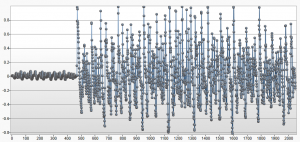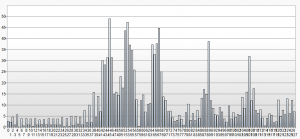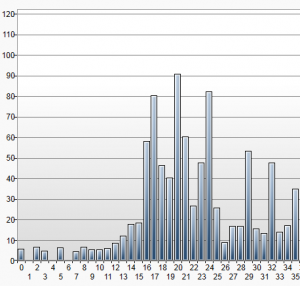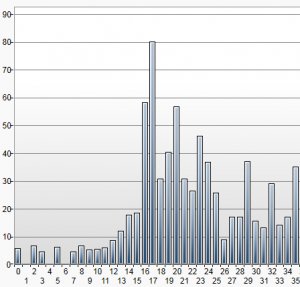A particularly ugly sound from the synthesizer was used to test profiling.
The following profile was produced. This shows a lot of overtones, one louder than the base note, others almost as loud.
The notes played were CDEF.
In polyphonic mode with no profiling the score transcribed shows that most of the overtones are interpreted as notes played.
With no profiling but in monophonic mode the overtones are loud enough that the wrong notes are picked.
Using the correlation profile method we get a lot better, but still with one overtone shown.
Using the rolling adjustment profile method we get an accurate representation of the notes played.
Note that all of these bars were produced with the same samples reprocessed with different options.
Drilling down to take a closer look at the second note D
The captured samples:
The FFT result shows an abundance of overtones. This is consistent with the profile.
The note mapping will interpret these frequencies as notes. We can see that 2 of the overtones have higher scores than the played note (D = 17)
The profiler output:
Only after this step does the played note emerge.
It is unlikely that any acoustic instrument will be nearly this difficult. Only by stressing the algorithms during testing can we be confident that we can provide a high degree of accuracy in realistic situations.
A voice with a long sustain was used to test the sustain compensation feature.
Notes played were ECDE.
Without sustain compensation we can see that each note carried over to the next.
With sustain compensation enabled the notes played were accurately scored.
Drilling down to take a closer look at the second note C:
The FFT results show the first peak on C, but also a residual peak on E.
Looking at the note values without sustain compensation enabled we can see that both C and E score enough to be scored.
Reprocessing the same samples with sustain compensation enabled we can see that the value given to the residual E (E = 19) is reduced.
The beta sign-up page on the web site is up. The first of the beta testers are signing up.
Time to think about Beta 2. I’ll continue to stress the algorithms – accuracy is everything. And of course respond to feed back from the beta 1 testers.
In addition a new tool is under development; a score editor. This will not be a full blown score editor, there are enough of those on the market. It will allow users to make modifications and corrections to the transposed score.



